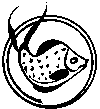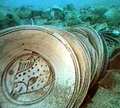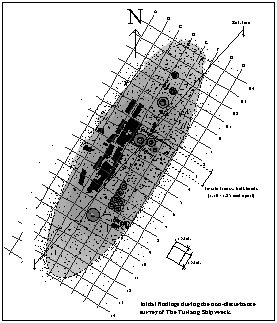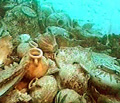 |
| Turiang |
16 Mar 2001
|
|||
| Last modified: 16 Mar 2001 |
From the first site inspections it was clear that trawlers' nets, scouring the seabed, had significantly damaged the Turiang site. Usually wrecks are covered by a mound of ceramics and other material: this had been shaved off and dispersed. Utilitarian ware is often found in the surface layer, probably because it was originally stowed on deck; its near-absence shows the extent of destruction. The remaining ceramic cargo had sunk into the seabed with the hull. Only the broken necks of a few large storage jars were visible at first inspection, along with a few iron oxide conglomerates.
In the hope of gleaning all possible historical information, which might for example include evidence of the ship's routing and the sequence of loading, a pre-disturbance survey was conducted, with detailed mapping of all visible features. This survey was guided by a numbered reference line, pegged to the seabed and stretched the length of the wreck at approximately 040/220 degrees. Each metre along this numbered line was thoroughly surveyed, with lateral measurements taken from the reference line. Later discovery of two transverse bulkheads confirmed the orientation of the vessel as 030/210 degrees, with the bow apparently pointing 210 degrees. The vessel lies at a depth of 43 metres. Diving conditions are favourable only in April and October.
 Despite
the heavy trawling damage, the starboard side of the vessel revealed many longitudinal
stacks of Sukhothai underglaze fish plates. All had damaged rims, but their
quantity was impressive. The port side was found covered with shards of broken
storage jars; shallow trenches indicated that this side of the vessel was loaded
with Thai jars of various sizes. (No other cargo was found on top of these jars;
the Royal Nanhai had similar jars, with many celadon dishes stacked on
top.) Forward of the storage jars were Vietnamese bowls together with brown-glazed
Chinese bowls. Below these were Chinese celadon dishes, which were in turn above
small and medium-sized brown Chinese jars. Larger Chinese celadon plates were
found stacked horizontally, upside down between and resting on the shoulders
of the large storage jars.
Despite
the heavy trawling damage, the starboard side of the vessel revealed many longitudinal
stacks of Sukhothai underglaze fish plates. All had damaged rims, but their
quantity was impressive. The port side was found covered with shards of broken
storage jars; shallow trenches indicated that this side of the vessel was loaded
with Thai jars of various sizes. (No other cargo was found on top of these jars;
the Royal Nanhai had similar jars, with many celadon dishes stacked on
top.) Forward of the storage jars were Vietnamese bowls together with brown-glazed
Chinese bowls. Below these were Chinese celadon dishes, which were in turn above
small and medium-sized brown Chinese jars. Larger Chinese celadon plates were
found stacked horizontally, upside down between and resting on the shoulders
of the large storage jars.
 |
| Chinese ceramics were concentrated towards the bow, south of line No.8. Sukhothai ware was found only amid-ship on the starboard side, and large Si-Satchanalai storage jars on the port side. Si-Satchanalai underglaze ware was concentrated aft, north of line No.1. |
Following the investigation and mapping of visible features, representative samples of ceramics were recovered from the surface and from some shallow pits on a grid layout throughout the wreck site. Each artefact was engraved on the base with a serial number corresponding to its location on the site. This permanent marking proved a practical way of tracking wet and dirty artefacts, expected to receive prolonged handling and chemical treatment. While marking, it was noted that similar wares (such as fish plates) differed significantly in hardness, depending on their firing temperature.
 The
Sukhothai and Si-Satchanalai wares were loaded in separate cargo compartments,
while Chinese and Vietnamese wares were found mixed in others. Plates from Si-Satchanalai
were all in the aft section, while smaller Si-Satchanalai jars and bottles were
scattered throughout the wreck. Chinese and Vietnamese wares were all forward.
The apparent density of ceramics suggests that the vessel was fully loaded.
All areas but the bow have Thai cargo, and the ship would have been impossibly
unbalanced if these areas had been empty during the voyage from China to Thailand.
The cargo could have been redistributed in Thailand, but it is much more likely
that some cargo was offloaded and replaced there.
The
Sukhothai and Si-Satchanalai wares were loaded in separate cargo compartments,
while Chinese and Vietnamese wares were found mixed in others. Plates from Si-Satchanalai
were all in the aft section, while smaller Si-Satchanalai jars and bottles were
scattered throughout the wreck. Chinese and Vietnamese wares were all forward.
The apparent density of ceramics suggests that the vessel was fully loaded.
All areas but the bow have Thai cargo, and the ship would have been impossibly
unbalanced if these areas had been empty during the voyage from China to Thailand.
The cargo could have been redistributed in Thailand, but it is much more likely
that some cargo was offloaded and replaced there.
| Turiang overview | Maritime Asia homepage | Next: the ship |